Mechanical Properties of Human Concentrated Growth Factor (CGF) Membrane and the CGF Graft with Bone Morphogenetic Protein-2 (BMP-2) onto Periosteum of the Skull of Nude Mice
Abstract
:1. Introduction
2. Results
2.1. Histological and SEM Findings of Concentrated Growth Factor (CGF) Glue
2.2. Initial Length, Width, and Thickness of CGF Membranes
2.3. Tensile Strength and Elastic Moduli
2.4. Concentrated Growth Factor with Recombinant Human Bone Morphogenetic Protein-2 (CGF/BMP-2) Membrane Onto Periosteum of Skull of Head Skins
2.5. Concentrated Growth Factor (CGF) Membrane Alone onto Periosteum of Skull of Head Skins
3. Discussion
4. Materials and Methods
4.1. Preparation of Concentrated Growth Factor (CGF) Glue
4.1.1. Histological Observation of Fresh CGF Glue
4.1.2. Scanning Electron Microscopy (SEM) Observation of Fresh CGF Glue
4.2. Mechanical test of Concentrated Growth Factor (CGF) Membrane
4.2.1. Preparations of Concentrated Growth Factor (CGF) Membrane
4.2.2. Mechanical Properties of Concentrated Growth Factor (CGF) Membrane
4.3. Animal Experiments
4.3.1. Preparation of Concentrated Growth Factor with Recombinant Human Bone Morphogenetic Protein 2 (CGF/BMP-2) Membranes
4.3.2. Ectopic Bioassay (Supra-Periosteal Site)
4.3.3. Tissue Preparation
4.4. Ethical Approval
5. Conclusions
Author Contributions
Funding
Institutional Review Board Statement
Informed Consent Statement
Conflicts of Interest
References
- Singer, A.J.; Clark, R.A. Cutaneous wound healing. N. Engl. J. Med. 1999, 341, 738–746. [Google Scholar] [CrossRef]
- Dhurat, R.; Sukesh, M.S. Principles and methods of preparation of platelet-rich plasma: A review and author’s perspective. J. Cutan Aesthet. Surg. 2014, 7, 189–197. [Google Scholar] [CrossRef]
- Murata, M.; Arisue, M. De novo bone formation using bovine collagen and platelet-rich plasma in animals. J. Hard Tissue. Biol. 2004, 13, 18–23. [Google Scholar] [CrossRef]
- Choukroun, J.; Diss, A.; Simonpieri, A.; Girard, M.O.; Schoeffler, C.; Dohan, S.L.; Dohan, A.J.J.; Mouhyi, J. Platelet-rich fibrin (PRF): A second-generation platelet concentrate. Part V: Histologic evaluations of PRF effects on bone allograft maturation in sinus lift. Oral Surg. Oral Med. Oral Pathol. Oral Radiol. Endod. 2006, 101, 299–303. [Google Scholar] [CrossRef] [PubMed]
- Dohan, D.M.; Corso, M.D.; Diss, A.; Mouhyi, J.; Charrier, J.B. Three-dimensional architecture and cell composition of a Choukroun’s platelet-rich fibrin clot and membrane. J. Periodontol. 2010, 81, 546–555. [Google Scholar] [CrossRef] [PubMed]
- Corigliano, M.; Sacco, L.; Baldoni, E. CGF- una proposta terapeutica per la medicina rigenerativa. Odontoiatria 2010, 1, 69–81. [Google Scholar]
- Yu, B.; Wang, Z. Effect of concentrated growth factors on beagle periodontal ligament stem cells in vitro. Mol. Med. Rep. 2014, 9, 235–242. [Google Scholar] [CrossRef]
- Qiao, J.; An, N.; Ouyang, X. Quantification of growth factors in different platelet concentrates. Platelets 2017, 28, 774–778. [Google Scholar] [CrossRef]
- Onji, K.; Kabir, M.A.; Zhu, B.; Yokozeki, K.; Saito, T.; Akazawa, T.; Murata, M. Human Fresh Fibrin Membrane with Bone Morphogenetic Protein-2 (BMP-2) Induces Bone Formation in the Subcutaneous Tissues of Nude Mice. Materials 2020, 14, 150. [Google Scholar] [CrossRef]
- Isobe, K.; Watanebe, T.; Kawabata, H.; Kitamura, Y.; Okudera, T.; Okudera, H.; Uematsu, K.; Okuda, K.; Nakata, K.; Tanaka, T.; et al. Mechanical and degradation properties of advanced platelet-rich fibrin (A-PRF), concentrated growth factors (CGF), and platelet-poor plasma-derived fibrin (PPTF). Int. J. Implant Dent. 2017, 3, 17. [Google Scholar] [CrossRef]
- Wozney, J.M.; Rosen, V.; Celeste, A.J.; Mitsock, L.M.; Whitters, M.J.; Kriz, R.W.; Hewick, R.M.; Wang, E.A. Novel regulators of bone formation: Molecular clones and activities. Science 1988, 242, 1528–1534. [Google Scholar] [CrossRef]
- Murata, M.; Hino, J.; Kabir, M.A.; Yokozeki, K.; Sakamoto, M.; Nakajima, T.; Akazawa, T. Osteoinduction in Novel Micropores of Partially Dissolved and Precipitated Hydroxyapatite Block in Scalp of Young Rats. Materials 2021, 14, 196. [Google Scholar] [CrossRef]
- Martínez-Sanz, E.; Ossipov, D.A.; Hilborn, J.; Larsson, S.; Jonsson, K.B.; Varghese, O.P. Bone reservoir: Injectable hyaluronic acid hydrogel for minimal invasive bone augmentation. J. Control Release 2011, 152, 232–240. [Google Scholar] [CrossRef]
- Zhang, Z.; Li, X.; Zhao, J.; Jia, W.; Wang, Z. Effect of autogenous growth factors released from platelet concentrates on the osteogenic differentiation of periodontal ligament fibroblasts: A comparative study. PeerJ 2019, 7, e7984. [Google Scholar] [CrossRef]
- Asparuhova, M.B.; Caballé-Serrano, J.; Buser, D.; Chappuis, V. Bone-conditioned medium contributes to initiation and progression of osteogenesis by exhibiting synergistic TGF-β1/BMP-2 activity. Int. J. Oral Sci. 2018, 10, 72–80. [Google Scholar] [CrossRef] [Green Version]
- Wang, Z.; Sun, J.; Li, Y.; Chen, C.; Xu, Y.; Zang, X.; Li, L.; Meng, K. Experimental study of the synergistic effect and network regulation mechanisms of an applied combination of BMP-2, VEGF, and TGF-β1 on osteogenic differentiation. J. Cell Biochem. 2019, 121, 2394–2405. [Google Scholar] [CrossRef]
- Friess, W.; Uludag, H.; Foskett, S.; Biron, R. Bone regeneration with recombinant human bone morphogenetic protein-2 (rhBMP-2) using absorbable collagen sponges (ACS): Influence of processing on ACS characteristics and formulation. Pharm. Dev. Technol. 1999, 4, 387–396. [Google Scholar] [CrossRef]
- Geiger, M.; Li, R.H.; Friess, W. Collagen sponges for bone regeneration with rhBMP-2. Adv. Drug. Deliv. Rev. 2003, 55, 1613–1629. [Google Scholar] [CrossRef] [PubMed]
- Kim, Y.K.; Um, I.W.; An, H.J.; Kim, K.W.; Hong, K.S.; Murata, M. Effects of demineralized dentin matrix used as an rhBMP-2 carrier for bone regeneration. J. Hard Tissue Biol. 2014, 23, 415–422. [Google Scholar] [CrossRef] [Green Version]
- Rodella, L.F.; Favero, G.; Boninsegna, R.; Buffoli, B.; Labanca, M.; Scari, G.; Sacco, L.; Batani, T.; Rezzani, R. Growth factors, CD34 positive cells, and fibrin network analysis in concentrated growth factors fraction. Microsc. Res. Tech. 2011, 74, 772–777. [Google Scholar] [CrossRef] [PubMed]
- Weisel, J.W.; Litvinov, R.I. Fibrin Formation, Structure and Properties. Subcell Biochem. 2017, 82, 405–456. [Google Scholar] [PubMed] [Green Version]
- Laronha, H.; Caldeira, J. Structure and Function of Human Matrix Metalloproteinases. Cells 2020, 9, 1076. [Google Scholar] [CrossRef] [PubMed]
- McKay, W.F.; Peckham, S.M.; Badura, J.M. A comprehensive clinical review of recombinant human bone morphogenetic protein-2 (INFUSE Bone Graft). Int. Orthop. 2007, 31, 729–734. [Google Scholar] [CrossRef] [Green Version]
- Tazaki, J.; Murata, M.; Akazawa, T.; Yamamoto, M.; Ito, K.; Arisue, M.; Shibata, T.; Tabata, Y. BMP-2 release and dose-response studies in hydroxyapatite and β-tricalcium phosphate. Biomed. Mater. Eng. 2009, 19, 141–146. [Google Scholar] [CrossRef] [PubMed]
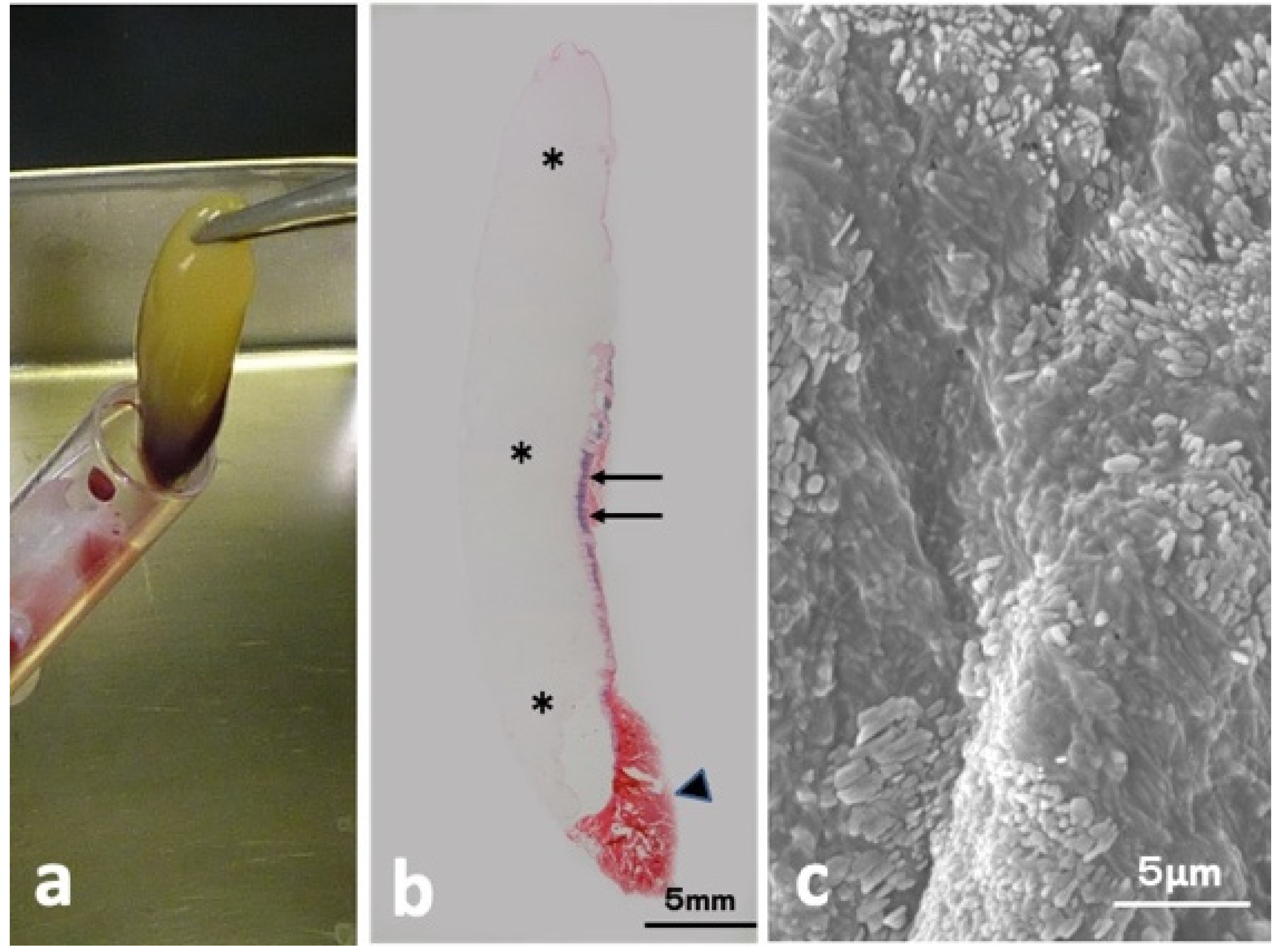
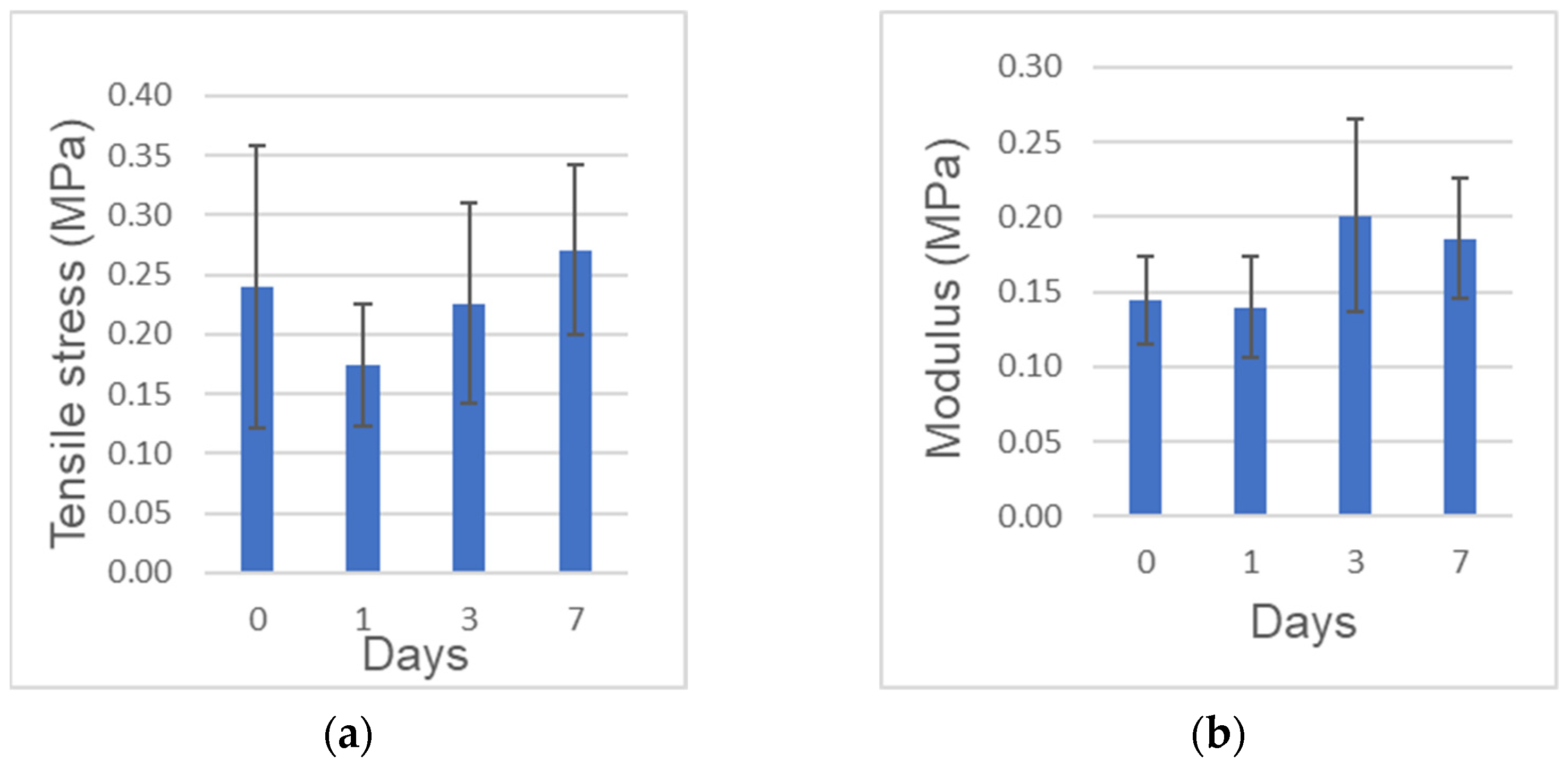
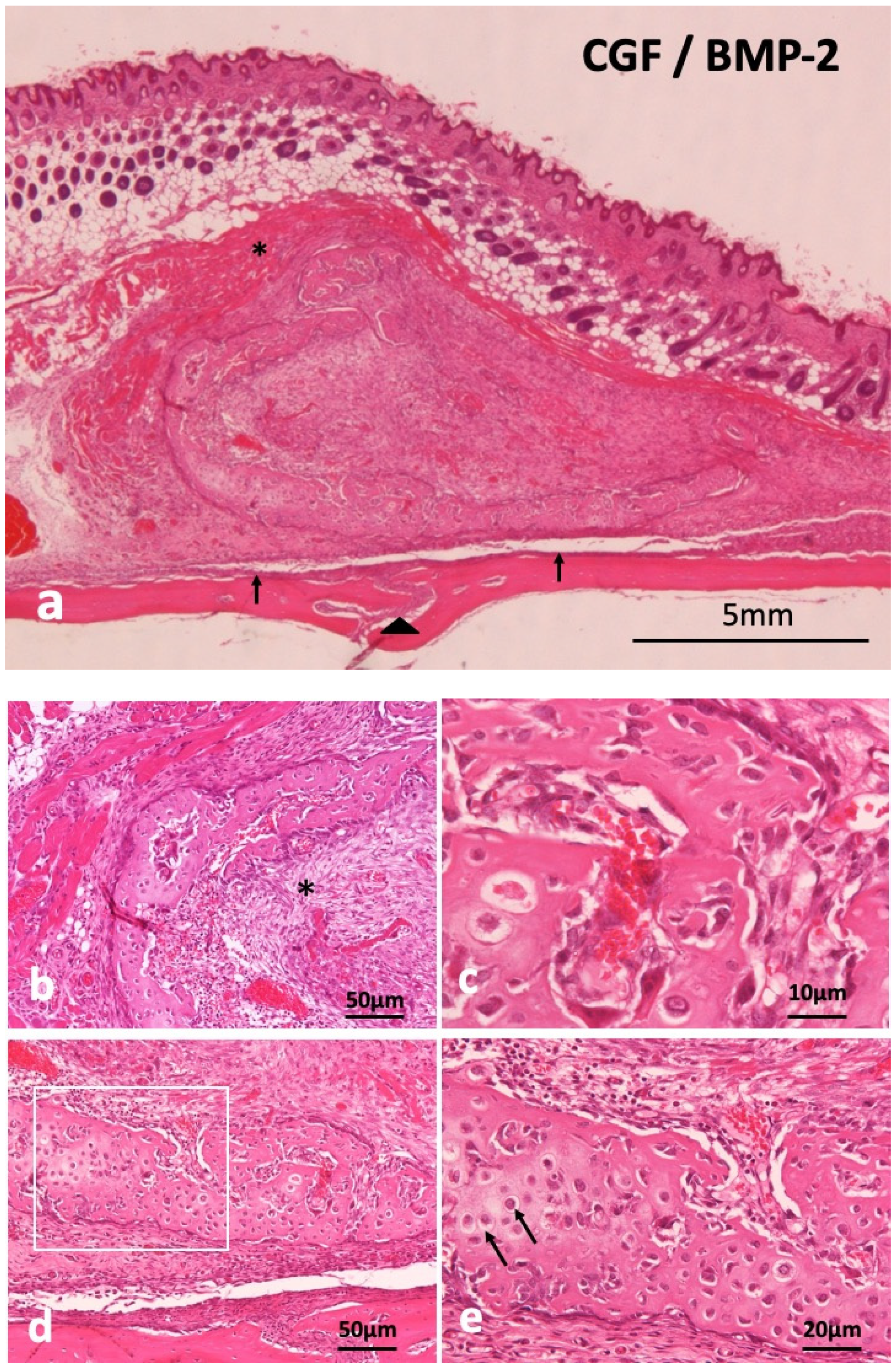


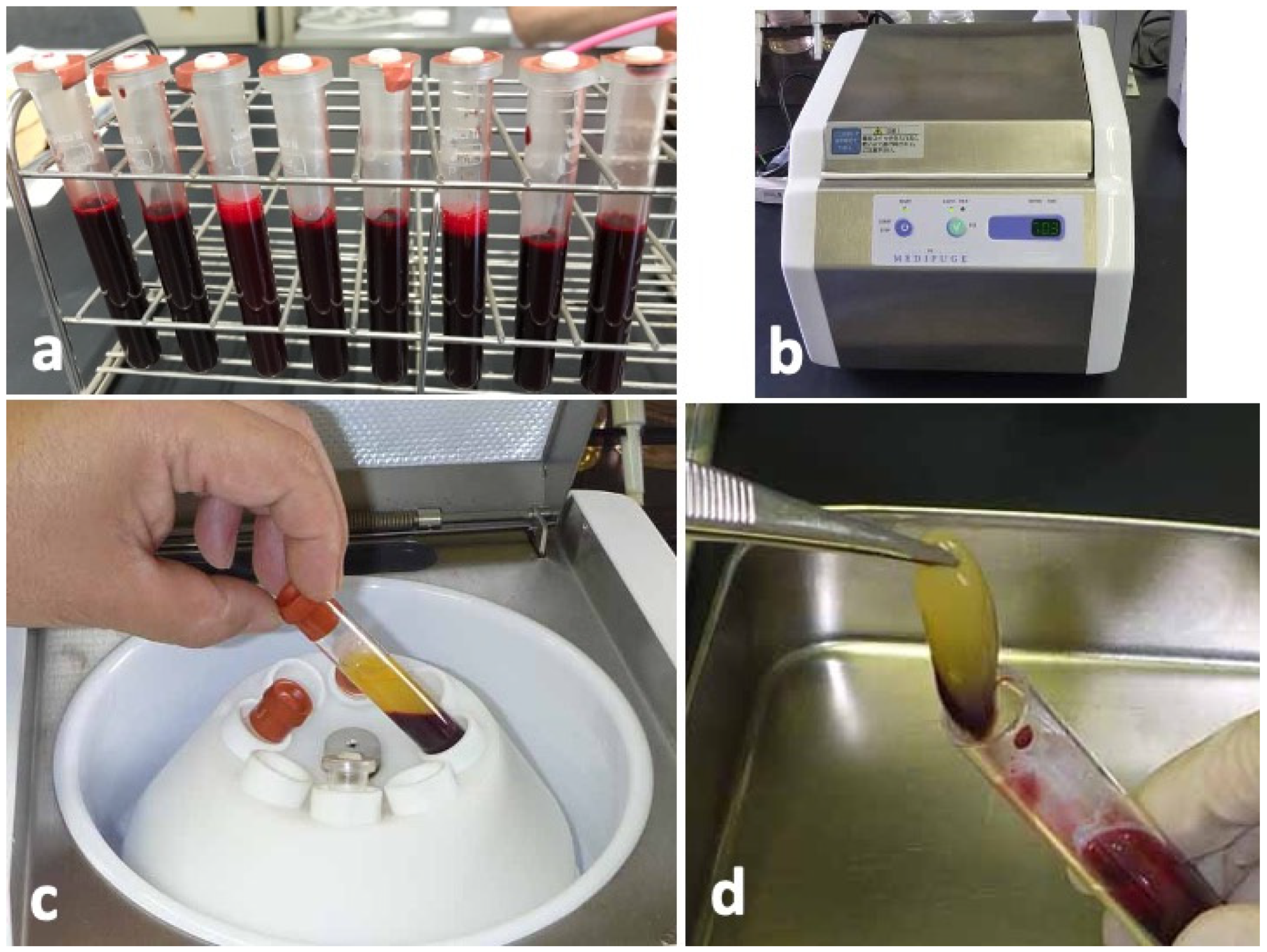
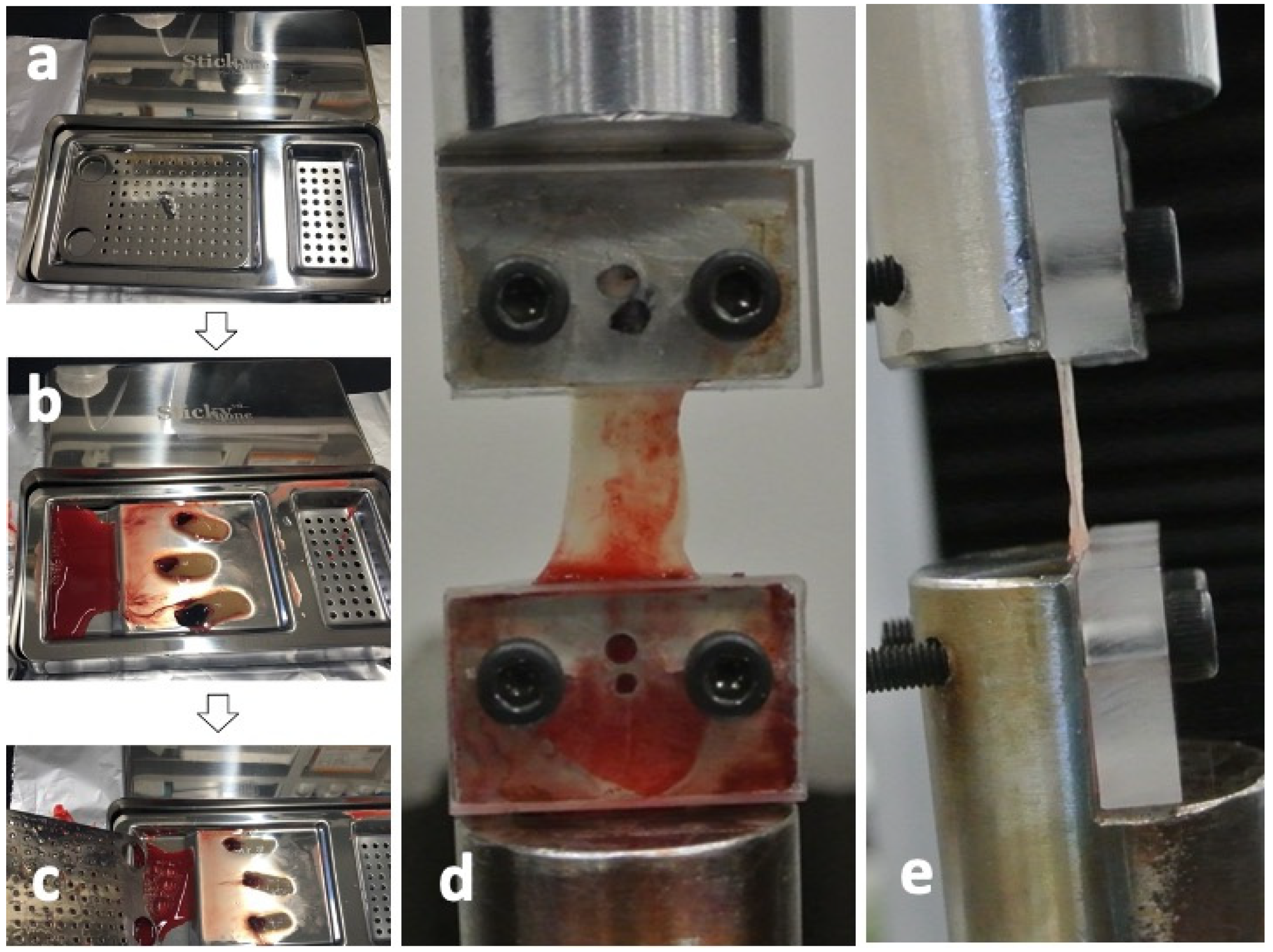
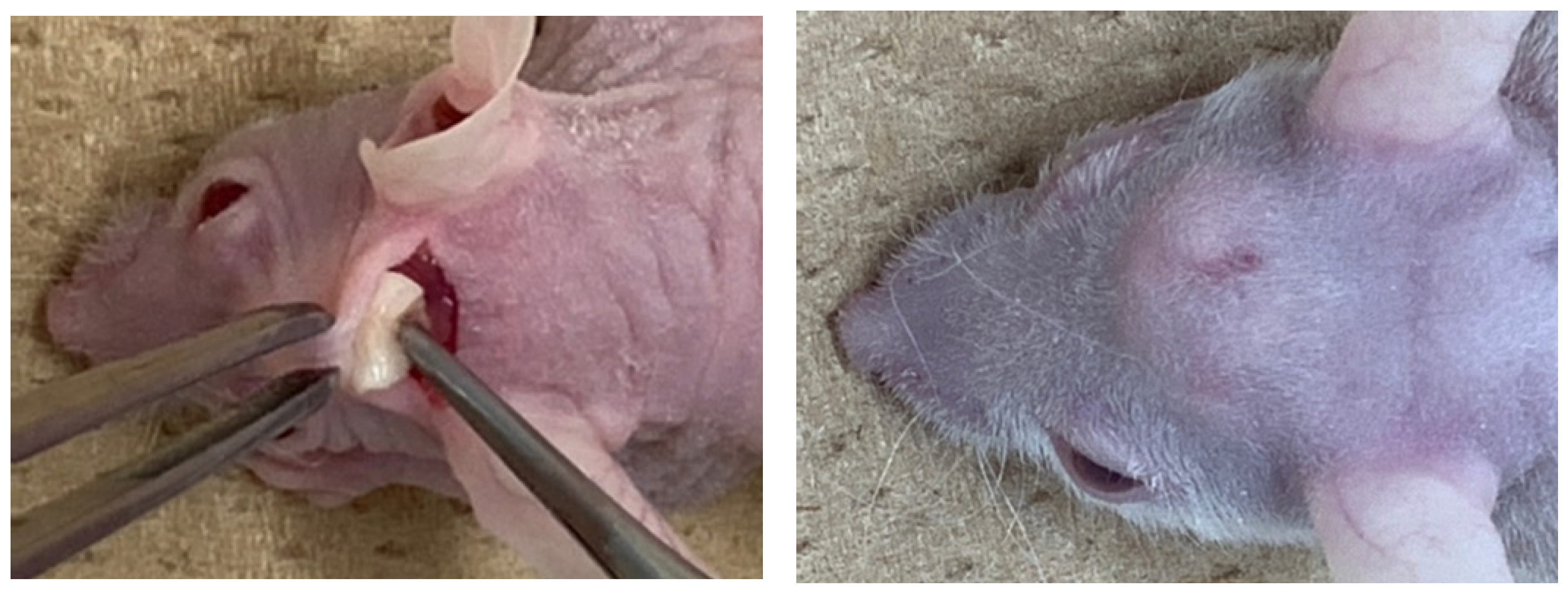
| Day | Length (mm) | Width (mm) | Thickness (mm) |
|---|---|---|---|
| 0 | 27.26 ± 1.38 | 7.27 ± 1.19 | 0.58 ± 0.10 |
| 1 | 28.92 ± 3.55 | 6.41 ± 0.74 | 0.58 ± 0.09 |
| 3 | 28.80 ± 1.59 | 7.13 ± 0.64 | 0.43 ± 0.07 |
| 7 | 26.02 ± 1.89 | 6.89 ± 0.80 | 0.45 ± 0.07 |
Publisher’s Note: MDPI stays neutral with regard to jurisdictional claims in published maps and institutional affiliations. |
© 2021 by the authors. Licensee MDPI, Basel, Switzerland. This article is an open access article distributed under the terms and conditions of the Creative Commons Attribution (CC BY) license (https://creativecommons.org/licenses/by/4.0/).
Share and Cite
Kabir, M.A.; Hirakawa, A.; Zhu, B.; Yokozeki, K.; Shakya, M.; Huang, B.; Akazawa, T.; Todoh, M.; Murata, M. Mechanical Properties of Human Concentrated Growth Factor (CGF) Membrane and the CGF Graft with Bone Morphogenetic Protein-2 (BMP-2) onto Periosteum of the Skull of Nude Mice. Int. J. Mol. Sci. 2021, 22, 11331. https://doi.org/10.3390/ijms222111331
Kabir MA, Hirakawa A, Zhu B, Yokozeki K, Shakya M, Huang B, Akazawa T, Todoh M, Murata M. Mechanical Properties of Human Concentrated Growth Factor (CGF) Membrane and the CGF Graft with Bone Morphogenetic Protein-2 (BMP-2) onto Periosteum of the Skull of Nude Mice. International Journal of Molecular Sciences. 2021; 22(21):11331. https://doi.org/10.3390/ijms222111331
Chicago/Turabian StyleKabir, Md. Arafat, Akihiro Hirakawa, Bowen Zhu, Kenji Yokozeki, Mamata Shakya, Bingzhen Huang, Toshiyuki Akazawa, Masahiro Todoh, and Masaru Murata. 2021. "Mechanical Properties of Human Concentrated Growth Factor (CGF) Membrane and the CGF Graft with Bone Morphogenetic Protein-2 (BMP-2) onto Periosteum of the Skull of Nude Mice" International Journal of Molecular Sciences 22, no. 21: 11331. https://doi.org/10.3390/ijms222111331
APA StyleKabir, M. A., Hirakawa, A., Zhu, B., Yokozeki, K., Shakya, M., Huang, B., Akazawa, T., Todoh, M., & Murata, M. (2021). Mechanical Properties of Human Concentrated Growth Factor (CGF) Membrane and the CGF Graft with Bone Morphogenetic Protein-2 (BMP-2) onto Periosteum of the Skull of Nude Mice. International Journal of Molecular Sciences, 22(21), 11331. https://doi.org/10.3390/ijms222111331








